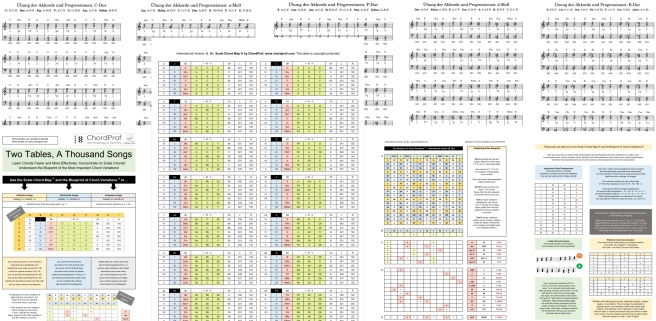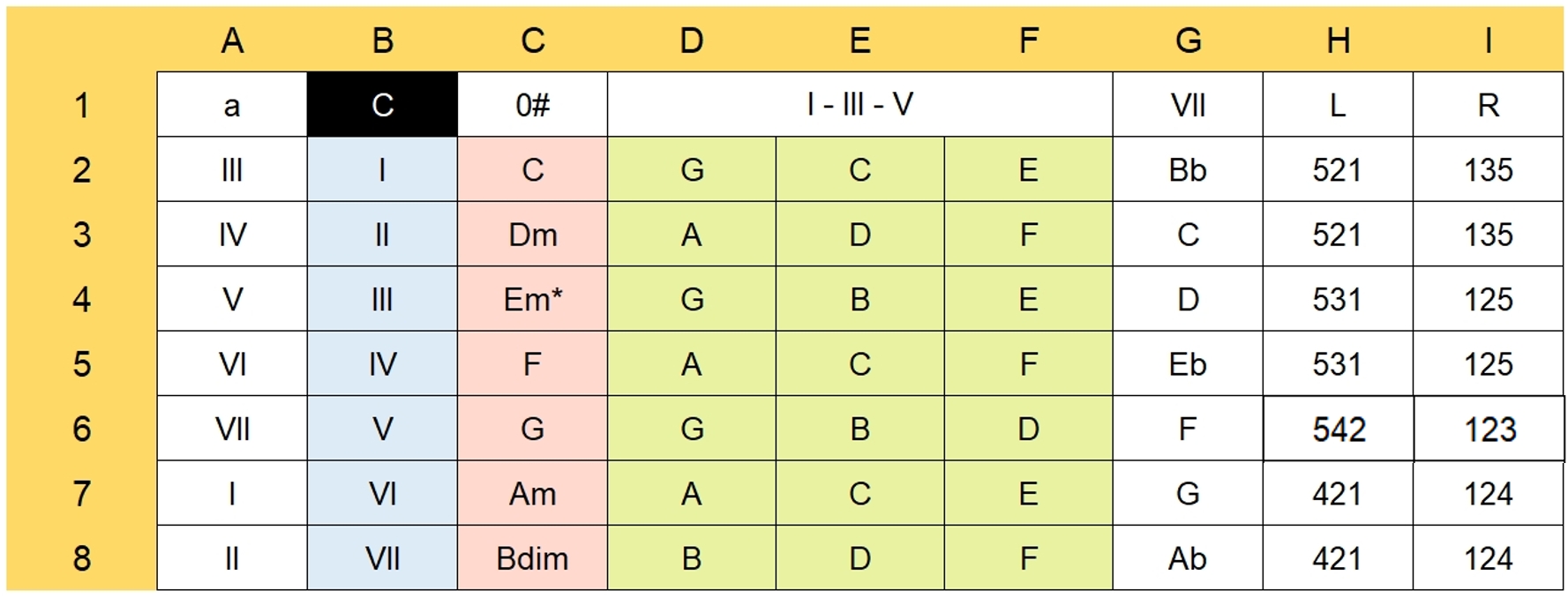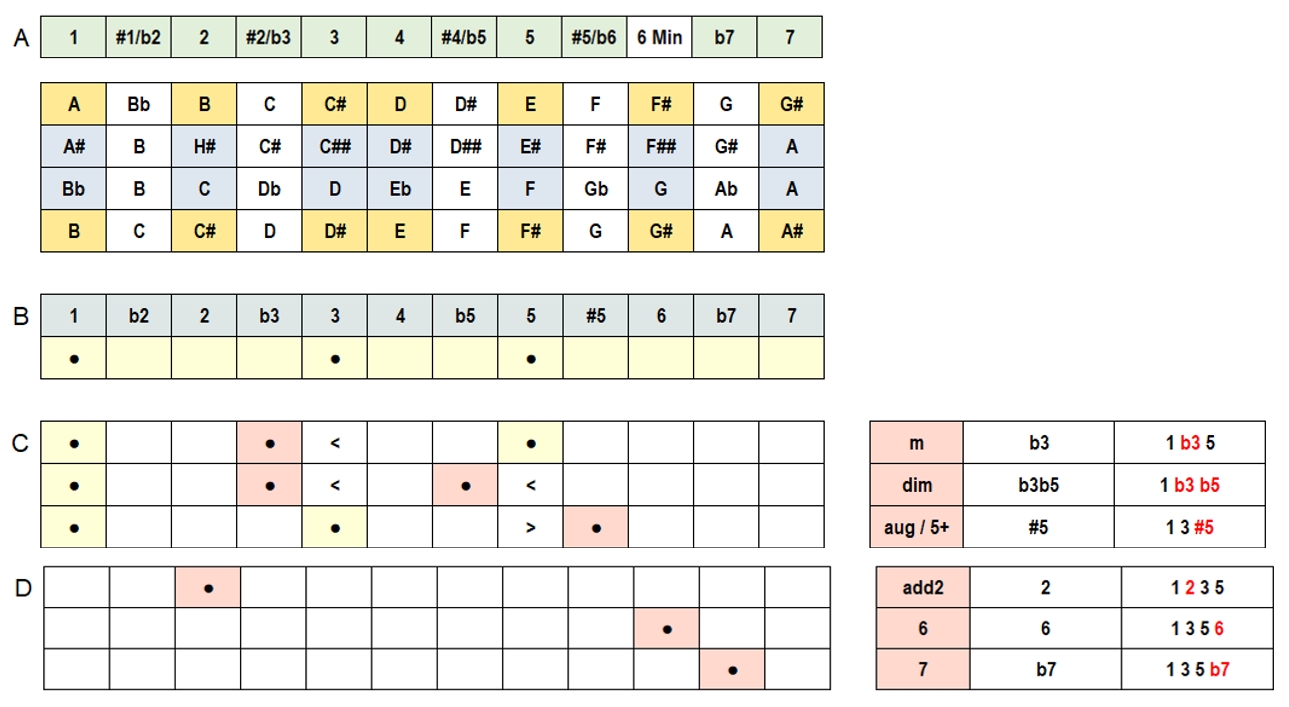
Music Chords Made Easy
Understanding and learning chords is a difficult project. You can’t remember the 2,500 or more chords that are listed in books and on websites. Even music professionals can’t tell you what a G#maug11 chord is without thinking about it. But there is a solution: use Chord Prof’s unique method and after only a few days you will master nearly all the chords you need. This is "Chords Made Easy".

With your knowledge of the Scale Chord Map (R) and the Blueprint of Chord Variations (R) you will be able to play the vast majority of existing folk, pop, rock, country and Christmas songs and will rarely have to look something up. However, you will have memorized not more than 25 chords (advanced: 43 chords) and 18 chord variations. If you are a piano or keyboard player, you will even already be familiar with the optimal "global" fingering. Doesn't this sound like a miracle? However, it is possible.
The Scale Chord Map

This is the first part of the miracle. Melodies are - to a certain extent - harmonized by scale chords. Scale chords are built on each degree of a scale. They only use notes of the scale and do not borrow notes from other scales. Most chord progressions (cadences) in pop music use scale chords.
In the first seven scales in the Circle of Fifths, C, F, G, Bb, D, Eb and A (these are the scales with a maximum of 3b or 3#), there are only 25 chords you have to learn (because some chords are part of several scales). If you advance to the scales with six b's or #'s, then your total workload is 43 chords. We suggest: Concentrate on scale chords! For all other chords, use the Blueprint of Chord Variations (R).
In the above extract of the Scale Chord Map (R) - which covers all 13 scales - you see the C major scale with the corresponding scale a minor. The key can be found in field B1. Additional informations are the key signature (field C1), the scale chords (fields C2 to C8), the optimal inversion of the scale chords (fields D2 to F8), the note that makes the chord a dominant seventh chord (fields G2 to G8), the fingering for the left hand (fields H2 to H8) and the right hand (fields I2 to I8) as well as the parallel minor key (field A1) with its deviant steps (fields A2 to A8).
To summarise so far: the table provides everything you need to know to play scale chords. You can also use the table to harmonize melodies (add chords to melodies without chords) and to compose music!
The Exercise Sheets (Extract)
You can use 14 Exercise Sheets to rehearse the chords in C, F, Bb, Eb, G, D, A and their corresponding minor scales, using the most popular chord progressions.

The Blueprint of Chord Variations

Though most chords of all famous folk, pop, rock, country and Christmas songs are scale chords (at least that is our observation), there are some other chords like Bbb5, Asus2 and Cmsus4 that you might find in music sheets. Do we have to go back to the books and the lists and the databases to identify them? No. All you have to do is to study the Blueprint of Chord Variations (R), of which you see an extract in the image above. Please note: It's only an extract. You see 4 of 13 rows in part A, 3 of 6 rows in part C and 3 of 11 rows in part D. All other rows are faded out.
How does it work? It's very simple. Let's start in Part A with the scales themselves. Which are the notes of the scale? You see this if you go from left to right using columns 1, 2, 3, 4, 5, 6 and 7 while skipping the white fields. A = A B C# D E F# G# (A). B = B C# D# E F# G# A# (B). You get the corresponding minor scale if you use columns 6 7 1 2 3 4 5, instead. Gray rows mark interchangeable scales (enharmony).
But let's concentrate on chords: Part B shows how the core chord 1-3-5 is built. Swipe from the dots upwards to find the chord in your key.
Part C shows variations changing the core chord. < and > indicate the change. Again, swipe from the dots upwards to find the variation in your key.
Part D shows variations without a core change. Instead, notes are added.
It is possible that there is more than one change, e.g. a "core change" plus an "add change". In these cases, you have to use the table twice.
Can you imagine now how powerful this instrument is? You understand that a chord variation is a very simple and transparent thing. And you can identify very quickly how the modified chord is built in the key you are actually interested in. The list of chord variations is not endlessly long. We’re talking about 18 variations in total. Of course, a lot of very rare variations have been excluded. But we estimate these are perhaps only one or two percent of all the chordsused in folk, pop, rock, country and Christmas songs. If you are looking for one of them, well, there are some books, lists and databases ...
How to get the full product
If you want to get both tables in their complete form, 14 Exercise Sheets and some other useful tables about chord progressions, chord inversion and rhythmical chord accentuation, e-mail us (see below). We'll send the document in PDF format immediately (which means as soon as possible, mostly on the same day).
Unfortunately, the ChordMaps can't be for free. The price is 11 Euros (one-time-fee; 10.28 Euros for us plus 7% German VAT = 0.72 Euros for the exchequer.) You do not have to pay in advance: The PDF comes as an attachment to the invoice. Sender is Werner Lauff (service@paypal.de). The subject of the E-Mail is "Invoice from Werner Lauff".
If you don't have a PayPal account, you can also make a normal money transfer from your bank account, provided you live in a SEPA country. In SEPA countries, payments in Euro to other SEPA countries do not incur additional costs, neither for you nor for us. SEPA countries are Austria, Belgium, Croatia, Cyprus, Estonia, Finland, France, Germany, Greece, Ireland, Italy, Latvia, Lithuania, Luxembourg, Netherlands, Portugal, Slovakia, Slovenia, and Spain. You will find our account number in the invoice as a "seller note to customer". Please note your E-Mail-address in the transfer form. We'll cancel your PayPal invoice afterwards.
Please e-mail us to order@chordprof.com with the subject "Chord Maps". Text something like: "Please send the chord maps for 11 Euros."
The first 18 pages of the PDF file are in English and use the international notation C-D-E-F-G-A-B-C with Bb as halftone. The pages 19 to 36 are in German and use the German notation C-D-E-F-G-A-H-C with B as semitone. If, for any reason, the PDF changes (errors, add-ons) you will automatically get a new version (up to 12 months after your initial order).
You may print the PDF for personal use. Please do not distribute copies of the PDF file, neither in digital nor in printed form.